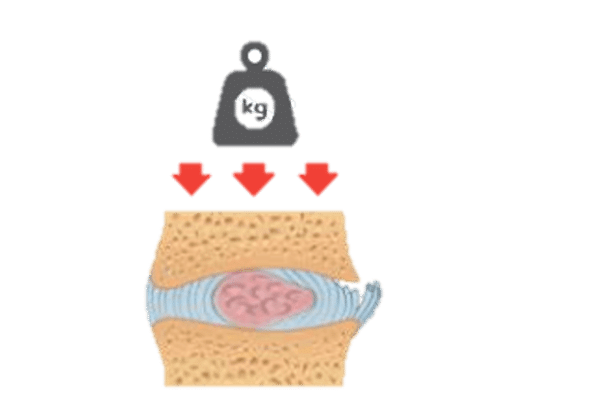Request Appointment
Enter your details and we will be in touch with you shortly;
Or call
8655885566
between 8 am and 8 pm.

A condition in which one vertebra from the spine slips over the adjacent bone

Spondylolisthesis is a spinal condition where one vertebra slips forward over the vertebra beneath. This displacement commonly occurs in the lower spine, particularly in the lumbar region, and can lead to pain, limited mobility, and nerve compression. It affects people of all ages, though it's more common in athletes, older adults, or those with spinal defects. Identifying the type and severity of slippage is key to deciding the right spondylolisthesis treatment plan.
There are several types of spondylolisthesis based on the underlying cause:
Early intervention through spondylolisthesis therapy can help prevent worsening of symptoms. Many patients benefit from spinal slippage management techniques such as physical therapy, posture correction, and core-strengthening exercises. In more severe cases, surgery might be considered. Proper diagnosis and consistent management are crucial for maintaining spinal stability and overall well-being.
Back pain is one of the most common symptoms of spondylolisthesis, although the condition might be asymptomatic for some people. Some of the other possible symptoms of spondylolisthesis include:
 Professional diagnosis required
Professional diagnosis required Chronic, can last for years
Chronic, can last for years Treatable with 8 weeks of QI Spine Therapy
Treatable with 8 weeks of QI Spine TherapySpondylolisthesis is most commonly associated with abnormal wear of the bones and cartilage, such as in the case of arthritis. This condition is more likely to affect individuals over 50 and is more prevalent in women than in men. The causes of spondylolisthesis include:
 Professional diagnosis required
Professional diagnosis required Chronic, can last for years
Chronic, can last for years Treatable with 4 weeks of QI Spine Therapy
Treatable with 4 weeks of QI Spine TherapyOnce a vertebra slips forward or backward, it cannot be shifted back into place. Since pain is a common symptom, conventional treatment for spondylolisthesis focuses on pain management through pain medications. However, pain medication only suppresses the pain, and so a patient is forced to stay on it permanently since the underlying problem is not addressed. Although doctors often suggest surgery for spondylolisthesis, newer studies show that conservative treatment is successful in up to 80% of all cases.
QI utilizes Frequency Specific Microcurrent (FSM) to reduce spondylolisthesis pain. This technology uses a low-level electric current to promote tissue repair, reduce inflammation, and eliminate back pain. FSM is often recommended for severe cases.
QI Spine uses Digital Spine Analysis (DSA), an advanced technology that provides precise functional diagnosis. Unlike MRI and X-ray tests that only identify bone and tissue damage, the DSA test can pinpoint the muscles that have weakened due to this condition. This ensures accurate and precise treatment for quick and lasting relief from spondylolisthesis.
QI Spine customises every treatment protocol depending on the needs of each patient. Each protocol is designed to reduce disability and pain and is derived from an algorithm based on over 47,000+ past cases. This ensures that every patient with lower back pain receives treatment that is best suited to their needs. Treatment protocols for spondylolisthesis generally focus on increasing the efficiency of local stabilizers (deep muscles) to prevent further shifting of the vertebral column and global stabilizers (superficial muscles) for maintenance. Spondylolisthesis can become severe and even debilitating if left untreated, and so it is essential to visit a spine specialist at the earliest for a definite diagnosis and timely treatment.
When a vertebra slips forward over the bone below it, it is referred to as spondylolisthesis. This could result from back pain, stiff muscles, and less flexibility in the back. While rest and medications help in the short term, structured exercises are essential for long-term spondylolisthesis relief therapy and spinal stability. The correct exercises can help ease your pain, correct your posture, and stop further slipping.
Below are some gentle, targeted exercises recommended as part of spondylolisthesis therapy:
Rest with your back down and your legs bent under you. Pull your stomach muscles in, making your back just touch the ground. Move and hold your facial muscles in this way for 5 seconds. Do this movement 10 to 15 times. Helps with spinal alignment correction and core support.
Get on your hands and knees before you begin. Stretch out your right arm and your left leg together. Stay still for 5 seconds, then repeat the same movement on the other side. Improves core strength and helps manage spinal slippage.
Lie down and bring one knee toward your chest while you hold the other leg bent or stretched out. Try to keep each position for between 20 and 30 seconds before switching to the next move. Provides lower back pain relief and eases tension.
Sit on your back with your knees bent up towards your body. If your back is flat, lift your hips so that there is a straight line from your shoulders to your knees. Drop the weight slowly after you are done holding it. Strengthens the glutes and supports management of lumbar spondylolisthesis.
Stand beside a wall and go down until your knees are perpendicular to the floor. Hold your breath for 10 to 15 seconds. Gives your legs and spine a workout, without placing pressure on your back.
Make sure to visit a physiotherapist before starting any exercise to prevent worsening your condition. These movements form the core of non-surgical spondylolisthesis treatment, helping to reduce reliance on surgical options for spondylolisthesis.
 Professional diagnosis required
Professional diagnosis required Chronic, can last for years
Chronic, can last for years Treatable with 4 weeks of QI Spine Therapy
Treatable with 4 weeks of QI Spine TherapyOnce a vertebra slips forward or backward, it cannot be shifted back into place. Since pain is a common symptom, conventional treatment for spondylolisthesis focuses on pain management through pain medications. However, pain medication only supresses the pain and so a patient is forced to stay on them permanently since the underlying problem is not addressed. Although doctors often suggest surgery for spondylolisthesis, newer studies show that conservative treatment is successful in up to 80% of all cases.
 Professional diagnosis required
Professional diagnosis required Chronic, can last for years
Chronic, can last for years Treatable with 4 weeks of QI Spine Therapy
Treatable with 4 weeks of QI Spine TherapySpondylolisthesis occurs when one vertebra slips forward over the one below it, usually in the lower back. Diagnosing this condition early is essential for timely spondylolisthesis relief therapy and to avoid long-term complications like nerve compression or chronic back pain. Symptoms such as persistent lower back pain, muscle tightness, leg weakness, or tingling often prompt a clinical evaluation.
Your doctor will begin by reviewing your medical history and performing a physical exam. This includes checking your posture, spine alignment, flexibility, and reflexes. Any signs of nerve involvement, like numbness or weakness in the legs, are carefully noted.
X-rays are the most commonly used imaging tool to confirm spondylolisthesis. They help determine the extent of vertebral slippage and the affected spinal level. Flexion-extension X-rays may also be used to assess spinal stability.
An MRI may be ordered to check for nerve root compression and disc condition. CT scans are sometimes recommended for a more detailed view of the bone structure, especially if surgery is being considered. These scans also help rule out other spinal conditions.
The condition is classified into grades (I to V) based on the degree of slippage. This helps guide the appropriate spondylolisthesis therapy, whether conservative care or surgical intervention.
Accurate diagnosis is crucial for managing spinal slippage, enabling targeted treatment that may include bracing, medication, or physical therapy. In most cases, non-invasive approaches are tried before surgery is considered. Early diagnosis improves the success of spondylolisthesis treatment and supports better long-term spine health.
At QI Spine, the diagnosis is made by understanding first the patient’s history, conducting a thorough physical examination, and doing a DSA (Digital Spine Analysis test), which helps analyze the root cause of the problem. It is a non-invasive functional test that helps in measuring spine function. Its controlled and guided movements help determine the spine's mobility, strength, and imbalances of muscles around the spine.
CT scans, MRIs, and X-rays often fail to pinpoint the exact source of pain, whereas DSA directly analyzes muscle tissue to identify the root cause. Here is how DSA is conducted & its benefits:
 Professional diagnosis required
Professional diagnosis required Chronic, can last for years
Chronic, can last for years Treatable with 4 weeks of QI Spine Therapy
Treatable with 4 weeks of QI Spine Therapy


Have a question?
Ask our spine specialists
Who is a QI Spine Specialist?
A QI Spine Specialist is a medical expert with

Dr. Nidhi Sanghvi Shah

Dr. Shital Gaikwad

Dr. Richa Bhatia
9000 hours
of specialisation in treating back and neck conditions
32 hours
of spine physiotherapy specialisation methods in McKenzie concepts, Kinetic control, Neurodynamic solutions, Mulligan’s concepts
500 hours
and 6 months of QI Spine specialisation courses
Spondylosis is wear and tear of the spine that occurs with age, commonly resulting in degeneration of joints and discs. Spondylolysis is a stress fracture or defect in the pars interarticularis of a vertebra. Though both lead to back pain, treatment for spondylolisthesis is required if slippage results from spondylolysis.
Yes, most instances of spondylolisthesis, particularly low-grade slips, can be treated with non-surgical spondylolisthesis treatment. This involves rest, bracing, physical therapy, and exercises to strengthen the core. Research indicates that as many as 80% of patients will get better without surgery.
Spondylolisthesis back pain is usually localized to the lower back and can radiate to the
buttocks or legs. It is generally exacerbated with movement, standing for prolonged periods, or bending. Nerve compression may also result in tingling, weakness, or numbness in the legs.